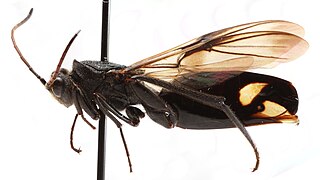
The genus Rattus refers to a specific genus of muroid rodents, all typically called rats. However, the term rat can also be applied to species outside of this genus.

Hoya is an Asclepiad genus of 200–300 species of tropical plants in the family Apocynaceae (Dogbane). Most are native to Asia including India, China, Thailand, Malaysia, Vietnam, and Indonesia, There is a great diversity of species in the Philippines, and species in Polynesia, New Guinea, and Australia.

Bothrochilus is a genus of nonvenomous pythonid snakes, which currently comprises seven species.
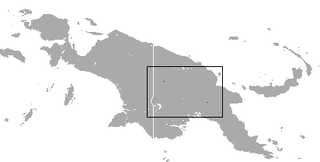
Bulmer's fruit bat is a megabat endemic to New Guinea. It is listed as a critically endangered species due to habitat loss and hunting. It is the only member of the genus Aproteles. Due to its imperiled status, it is identified by the Alliance for Zero Extinction as a species in danger of imminent extinction.

The New Guinea big-eared bat, species Pharotis imogene, is a vespertilionid bat endemic to Papua New Guinea. It is listed as a critically endangered species due to ongoing habitat loss. It is the only known member of the genus Pharotis, which is closely related to Nyctophilus.

Barygenys is a genus of microhylid frogs. They are endemic to New Guinea and the adjacent Louisiade Archipelago. So far only known from Papua New Guinea, the range of the genus is expected to reach Papua province in the Indonesian part of New Guinea. Despite not being known from Papua, common name Papua frogs has been suggested for them.

Albericus is a genus of microhylid frogs endemic to New Guinea. These are small frogs with maximum body length around 27 mm. The genus was described in 1995, when three species in Cophixalus were separated as a new genus. The genus name Albericus is the Latin form of Alberich, shape-shifting dwarf in the epic poem Nibelungenlied. Several species derive also their specific names from Nibelungenlied, e.g. A. siegfriedi from Siegfried and A. fafniri from Fafnir.

The New Guinea long-eared bat, species Nyctophilus microtis, is a small flying mammal. It is found only in Papua New Guinea.
The squirrel-toothed rat, also known as the New Guinea giant rat, powerful-toothed rat, uneven-toothed rat, or narrow-toothed giant rat, is a species of rodent in the family Muridae. It is the only species in the genus Anisomys and is found in New Guinea.
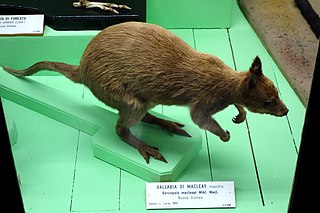
Macleay's dorcopsis, also known as the Papuan dorcopsis or the Papuan forest wallaby, is a species of marsupial in the family Macropodidae. It is endemic to Papua New Guinea, where its natural habitat is subtropical or tropical dry forests. Being little threatened by habitat destruction, the International Union for Conservation of Nature has rated it as being of "least concern".
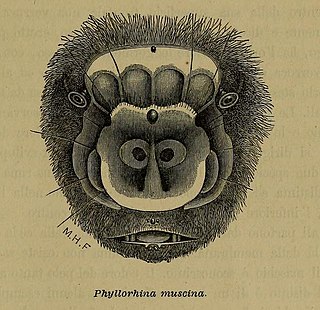
The Fly River roundleaf bat is a species of bat in the family Hipposideridae. It is found in West Papua, Indonesia and Papua New Guinea.

The Biak roundleaf bat or Geelvinck Bay leaf-nosed bat is a species of bat in the family Hipposideridae. It is endemic to the Biak Islands and Cenderawasih Bay area of Papua Province, located in Western New Guinea, Indonesia.

The lesser tube-nosed fruit bat or unstriped tube-nosed bat is a species of megabat in the family Pteropodidae found in West Papua, Indonesia and Papua New Guinea.

New Guinea is a large island separated by a shallow sea from the rest of the Australian continent. It is the world's second-largest island, after Greenland, covering a land area of 785,753 km2 (303,381 sq mi), and the largest wholly or partly within the Southern Hemisphere and Oceania.
Hemiscyllium is a genus of sharks in the family Hemiscylliidae.
The Papuan seerfish also called the Papuan Spanish mackerel, is a species of fish in the Scombridae family. It is endemic to the Gulf of Papua off the mouth of the Fly River. It is the smallest species in the genus Scomberomorus. Sexual maturity is attained at much less than 30 cm fork length.
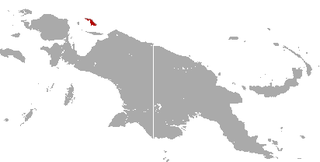
The blue-eyed spotted cuscus or Biak spotted cuscus is a species of marsupial in the family Phalangeridae. It is endemic to the islands of Biak and Supiori in the Cenderawasih Bay in West Papua of Indonesia. Only scientifically described in 2004, it appears to be very rare, likely due to hunting and habitat loss, and has consequently been rated as critically endangered by the IUCN. Recent surveys have failed to find any wild individuals. Unlike all other members of the genus Spilocuscus, this relatively small species has distinct pale blue eyes.
Paramelomys is a genus of rodent. All of the nine species of the genus are found in West Papua, Indonesia and Papua New Guinea.
Stemmocryptidae is a very small family of bugs in the order Hemiptera, known from Papua New Guinea. There is only one species in one genus, Stemmocrypta antennata.
